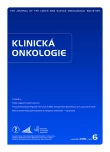A Case of Delayed Diagnosis of Acral Lentiginous Melanoma
Authors:
M. Gottvaldová 1; H. Jedličková 1; A. Poprach 2; V. Vašků 1
Authors place of work:
I. dermatovenerologická klinika LF MU a FN U sv. Anny v Brně
1; Klinika onkologické péče, Masarykův onkologický ústav, Brno
2
Published in the journal:
Klin Onkol 2015; 28(6): 439-443
Category:
Kazuistiky
doi:
https://doi.org/10.14735/amko2015439
Maligní melanom je nádorové onemocnění kůže, které vzniká nekontrolovanou proliferací melanocytů. Nejčastěji se objevuje na kůži, ale může postihnout i sliznice, meningy či oko. Část melanomů se vyvíjí z melanocytárního névu. Akrolentiginózní melanom je typ melanomu lokalizovaný na dlaních, chodidlech, prstech, pod nehty, a je nejčastějším typem melanomu u fototypu VI. Nejdůležitějším faktorem úspěšné léčby je včasná detekce a excize tumoru s histologickým stagingem.
Summary
Background:
Melanoma is a malignant skin disease. The tumor development is caused by an uncontrollable proliferation of melanocytes. The most common occurrence is on the skin, but melanoma may also develop on the mucous membrane, meninges, and eyes. Some melanomas develop from melanocytic nevus. Acral lentiginous melanoma occurs on palms, feet, fingers and under nails, and is the most common type of melanoma for phototype VI. The most important factor for successful treatment of malignant melanoma is an early detection, excision of the primary tumor and histological staging. Surgical treatment of an early-stage melanoma is a key to successful therapy; however, many patients (mostly men) do not seek medical attention before it istoo late.
Case report:
This case study presents a 59-year-old patient, who suffers from white coat syndrome and whose finger was amputated for alleged gangrene. Subsequently, brownish black nodules appeared across his arm. Histological examination proved metastases of malignant melanoma. It was only at this phase, when the patient admitted a nevus at the tip of his amputated finger, from which ulceration and gangrene gradually emerged.
Conclusion:
This case demonstrates a combination of multiple unfavorable factors, which led to delayed diagnosis and therapy.
Key words:
acral lentiginous melanoma – histology – neoplasm metastasis – gene amplifications – white coat syndrome
The authors declare they have no potential conflicts of interest concerning drugs, products, or services used in the study.
The Editorial Board declares that the manuscript met the ICMJE recommendation for biomedical papers.
Submitted:
4. 9. 2015
Accepted:
1. 10. 2015
Zdroje
1. Feibleman CE, Stoll H, Maize JC. Melanomas of the palm, sole, and nailbed: a clinicopathologic study. Cancer 1980; 46(11): 2492 – 2504.
2. Seiji M, Takematsu H, Hosokawa M et al. Acral melanoma in Japan. J Invest Dermatol 1983; 80 (Suppl): 56s – 60s.
3. Coleman WP, Philip RL, Reed RR et al. Acral lentiginous melanoma. Arch Dermat 1980; 116(7): 773 – 776.
4. Kaplan I, Youngleson J. Malignant melanomas in the South African Bantu. Br J Plast Surg 1972; 25(1): 65 – 68.
5. Cannon‑Albright LA, Goldgar DE, Meyer LJ et al. Assignment of a locus for familial melanoma, MLM, to chromosome 9p13/ p22. Science 1992; 258(5085): 1148 – 1152.
6. Maldonado JL, Fridlyand J, Patel H et al. Determinants of BRAF mutations in primary melanomas. J Natl Cancer Inst 2003; 95(24): 1878 – 1890.
7. LeBoit PE, Burg G, Weedon D et al. Pathology and genetics of skin tumours. Lyn: IARC Press 2006 : 75.
8. Krajsová I (ed.). Melanom. Praha: Maxdorf 2006 : 123 – 125, 332.
9. Kuchelmeister C, Schaumburg ‑ Lever G, Grabe C. Acral cutaneous melanoma in caucasians: clinical features, histopatology and prognosis in 112 patients. Br J Dermatol 2000; 143(2): 275 – 280.
10. Bradford PT, Goldstein AM, McMaster ML et al. Acral lentiginous melanoma: incidence and survival patterns in the United States, 1986 – 2005. Arch Dermatol 2009; 145(4): 427 – 434. doi: 10.1001/ archdermatol.2008.609.
11. Uzis.cz [internetová stránka]. Ústav zdravotnických informací a statistiky ČR, Česká republika [aktualizováno 13. května 2014; citováno 4. září 2015]. Dostupné z: www.uzis.cz.
12. Modrá kniha České onkologické společnosti. 17. vyd. Brno: Masarykův onkologický ústav 2013 : 290.
13. Brochez L, Verhaeghe E, Bleyen L et al. Diagnostic ability of general practitioners and dermatologists in discriminating pigmented skin lesions. J Am Acad Dermatol 2001; 44(6): 979 – 986.
14. Morton CA, Mackie RM. Clinical accuracy of the diagnosis of cutaneous malignant melanoma. Br J Dermatol 1998; 138(2): 283 – 287.
15. Tran KT, Wright NA, Cockerell CJ. Biopsy of the pigmented lesion – when and how. J Am Acad Dermatol 2008; 59(5): 852 – 871. doi: 10.1016/ j.jaad.2008.05.027.
Štítky
Dermatologie Dětská dermatologie Dětská onkologie Chirurgie všeobecná OnkologieČlánek vyšel v časopise
Klinická onkologie

2015 Číslo 6
- Isoprinosin je bezpečný a účinný v léčbě pacientů s akutní respirační virovou infekcí
- Metamizol jako analgetikum první volby: kdy, pro koho, jak a proč?
- Inosin pranobex v léčbě chřipky a dalších respiračních infekcí virové etiologie
- Open abdomen
Nejčtenější v tomto čísle
- Případ pozdně diagnostikovaného akrolentiginózního melanomu
- Triple negativní karcinom prsu
- Imunoterapie v prevenci a léčbě karcinomu prsu
-
Onkologie v obrazech
Kolizní duplicitní nádory
